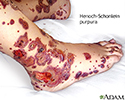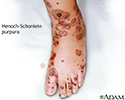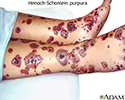Henoch-Schönlein purpura
Leukocytoclastic vasculitis; Anaphylactoid purpura; Vascular purpura
Henoch-Schönlein purpura is a disease that involves purple spots on the skin, joint pain, gastrointestinal problems, and glomerulonephritis (a type of kidney disorder).
Glomerulonephritis
Glomerulonephritis is a type of kidney disease in which the part of your kidneys that helps filter waste and fluids from the blood is damaged....

Causes
Henoch-Schönlein is caused by an abnormal response of the immune system. The result is inflammation in the microscopic blood vessels in the skin. Blood vessels in the joints, kidneys, or the intestines may also be affected. It is unclear why this occurs.
The syndrome is mostly seen in children, but it may affect people of any age. It is more common in boys than in girls. Many people who develop this disease had an upper respiratory infection in the weeks before.
Symptoms
Symptoms may include:
-
Abdominal pain
Abdominal pain
Abdominal pain is pain that you feel anywhere between your chest and groin. This is often referred to as the stomach region or belly.
 ImageRead Article Now Book Mark Article
ImageRead Article Now Book Mark Article - Joint pain
-
Purple spots on the skin (
purpura
), usually over the buttocks, lower legs, and elbows
Purpura
Purpura is purple-colored spots and patches that occur on the skin, and in mucus membranes, including the lining of the mouth.
 ImageRead Article Now Book Mark Article
ImageRead Article Now Book Mark Article -
Bloody diarrhea
Bloody diarrhea
Bloody stools often are a sign of a problem in the digestive tract. Blood in the stool may come from anywhere along your digestive tract from your m...
Read Article Now Book Mark Article -
Hives
or
angioedema
Hives
Hives are raised, often itchy, red bumps (welts) on the surface of the skin. They are usually an allergic reaction to food or medicine. They can al...
 ImageRead Article Now Book Mark Article
ImageRead Article Now Book Mark ArticleAngioedema
Angioedema is swelling that is similar to hives, but the swelling is under the skin instead of on the surface. Hives are often called welts. They a...
Read Article Now Book Mark Article - Nausea
- Diarrhea
-
Painful menstruation
Painful menstruation
Painful menstrual periods are periods in which a woman has crampy lower abdominal pain, which can be sharp or aching and come and go. Back pain may ...
 ImageRead Article Now Book Mark Article
ImageRead Article Now Book Mark Article - Vomiting
Exams and Tests
The health care provider will look at your body and look at your skin. The physical exam will show skin sores (purpura, lesions) and joint tenderness.
Tests may include:
-
Skin biopsy
Skin biopsy
A skin lesion biopsy is when a small amount of skin is removed so it can be examined. The skin is tested to look for skin conditions or diseases. A...
 ImageRead Article Now Book Mark Article
ImageRead Article Now Book Mark Article -
Urinalysis
Urinalysis
Urinalysis is the physical, chemical, and microscopic examination of urine. It involves a number of tests to detect and measure various compounds th...
 ImageRead Article Now Book Mark Article
ImageRead Article Now Book Mark Article - Blood tests to look for other causes of blood vessel inflammation, such as systemic lupus erythematosus or hepatitis
Treatment
There is no specific treatment. Most cases go away on their own. If symptoms do not go away, you need to take corticosteroid medicine such as prednisone.
Outlook (Prognosis)
The disease most often gets better on its own.
Possible Complications
Complications may include:
- Bleeding inside the body
- Kidney problems (in rare cases)
When to Contact a Medical Professional
Call your provider if:
- You develop symptoms of Henoch-Schönlein purpura, and they last for more than a few days.
-
You have
low urine output
after an episode of Henoch-Schönlein purpura.
Low urine output
Decreased urine output means that you produce less urine than normal. Most adults make at least 500 ml of urine in 24 hours (a little over 2 cups)....
 ImageRead Article Now Book Mark Article
ImageRead Article Now Book Mark Article
References
Ardoin SP, Fels E. Vasculitis syndromes. In: Kliegman RM, Stanton B, St. Geme J, Schor N, Behrman RE, eds. Nelson Textbook of Pediatrics . 19th ed. Philadelphia, PA: Elsevier Saunders; 2011:chap 161.
Marcdante KJ, Kliegman RM. Henoch-Schöenlein purpura. In: Marcdante KJ, Kliegman RM, eds. Nelson Essentials of Pediatrics . 7th ed. Philadelphia, PA: Elsevier Saunders; 2015:chap 87.
-
Henoch-Schonlein purpura on the lower legs - illustration
Henoch-Schonlein Purpura: This disorder usually presents with red to purple bumps on the legs, often accompanied by aching in the joints and fever. This condition follows an infection and usually resolves without treatment. Skin lesions most commonly occur below the knee but may also be seen on the thigh, buttocks, and rarely on the arms.
Henoch-Schonlein purpura on the lower legs
illustration
-
Henoch-Schonlein purpura - illustration
Henoch-Schonlein is a type of hypersensitivity vasculitis and inflammatory response within the blood vessel. It is caused by an abnormal response of the immune system. The exact cause for this disorder is unknown.
Henoch-Schonlein purpura
illustration
-
Henoch-Schonlein purpura - illustration
The syndrome is usually seen in children, but people of any age may be affected. It is more common in boys than in girls. Many people with Henoch-Schonlein purpura had an upper respiratory illness in the previous weeks.
Henoch-Schonlein purpura
illustration
-
Henoch-Schonlein purpura - illustration
There is no specific treatment for Henoch-Schonlein purpura. Most cases resolve spontaneously without treatment. If symptoms persist, therapy with corticosteroids such as prednisone is usually tried.
Henoch-Schonlein purpura
illustration
-
Henoch-Schonlein purpura on an infant's foot - illustration
Henoch-Schonlein purpura is more commonly seen in children than adults and often occurs after an upper respiratory infection. It causes skin rashes that bleed into the skin (petechiae and purpura). Bleeding may also occur from the gastrointestinal tract and kidneys.
Henoch-Schonlein purpura on an infant's foot
illustration
-
Henoch-Schonlein purpura on an infant's legs - illustration
Henoch-Schonlein purpura is more commonly seen in children than adults and often occurs after an upper respiratory infection. It causes skin rashes that bleed into the skin (petechiae and purpura). Bleeding may also occur from the gastrointestinal tract and kidneys.
Henoch-Schonlein purpura on an infant's legs
illustration
-
Henoch-Schonlein purpura on an infant's legs - illustration
Henoch-Schonlein purpura is more commonly seen in children than adults and often occurs after an upper respiratory infection. It causes skin rashes that bleed into the skin (petechiae and purpura). Bleeding may also occur from the gastrointestinal tract and kidneys.
Henoch-Schonlein purpura on an infant's legs
illustration
-
Henoch-Schonlein purpura on the legs - illustration
Henoch-Schonlein purpura is more commonly seen in children than adults and often occurs after an upper respiratory infection. It causes skin rashes that bleed into the skin (petechiae and purpura). Bleeding may also occur from the gastrointestinal tract and kidneys.
Henoch-Schonlein purpura on the legs
illustration
-
Henoch-Schonlein purpura on the lower legs - illustration
Henoch-Schonlein Purpura: This disorder usually presents with red to purple bumps on the legs, often accompanied by aching in the joints and fever. This condition follows an infection and usually resolves without treatment. Skin lesions most commonly occur below the knee but may also be seen on the thigh, buttocks, and rarely on the arms.
Henoch-Schonlein purpura on the lower legs
illustration
-
Henoch-Schonlein purpura - illustration
Henoch-Schonlein is a type of hypersensitivity vasculitis and inflammatory response within the blood vessel. It is caused by an abnormal response of the immune system. The exact cause for this disorder is unknown.
Henoch-Schonlein purpura
illustration
-
Henoch-Schonlein purpura - illustration
The syndrome is usually seen in children, but people of any age may be affected. It is more common in boys than in girls. Many people with Henoch-Schonlein purpura had an upper respiratory illness in the previous weeks.
Henoch-Schonlein purpura
illustration
-
Henoch-Schonlein purpura - illustration
There is no specific treatment for Henoch-Schonlein purpura. Most cases resolve spontaneously without treatment. If symptoms persist, therapy with corticosteroids such as prednisone is usually tried.
Henoch-Schonlein purpura
illustration
-
Henoch-Schonlein purpura on an infant's foot - illustration
Henoch-Schonlein purpura is more commonly seen in children than adults and often occurs after an upper respiratory infection. It causes skin rashes that bleed into the skin (petechiae and purpura). Bleeding may also occur from the gastrointestinal tract and kidneys.
Henoch-Schonlein purpura on an infant's foot
illustration
-
Henoch-Schonlein purpura on an infant's legs - illustration
Henoch-Schonlein purpura is more commonly seen in children than adults and often occurs after an upper respiratory infection. It causes skin rashes that bleed into the skin (petechiae and purpura). Bleeding may also occur from the gastrointestinal tract and kidneys.
Henoch-Schonlein purpura on an infant's legs
illustration
-
Henoch-Schonlein purpura on an infant's legs - illustration
Henoch-Schonlein purpura is more commonly seen in children than adults and often occurs after an upper respiratory infection. It causes skin rashes that bleed into the skin (petechiae and purpura). Bleeding may also occur from the gastrointestinal tract and kidneys.
Henoch-Schonlein purpura on an infant's legs
illustration
-
Henoch-Schonlein purpura on the legs - illustration
Henoch-Schonlein purpura is more commonly seen in children than adults and often occurs after an upper respiratory infection. It causes skin rashes that bleed into the skin (petechiae and purpura). Bleeding may also occur from the gastrointestinal tract and kidneys.
Henoch-Schonlein purpura on the legs
illustration
Review Date: 4/28/2015
Reviewed By: Gordon A. Starkebaum, MD, Professor of Medicine, Division of Rheumatology, University of Washington School of Medicine, Seattle, WA. Also reviewed by David Zieve, MD, MHA, Isla Ogilvie, PhD, and the A.D.A.M. Editorial team.









